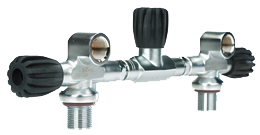|
This configuration differs from the twin independent system in that the valves of the two cylinders are joined with an isolation manifold. Only stainless steel bands can be used. Only one SPG is carried and one second stage regulator typically is on a long (1.5 or 1.8m) hose.
With the isolation valve on the manifold open the diver effectively breathes one large gas supply monitored by the single SPG.
Advantages
- If there is an issue with a leaking hose or regulator the diver can isolate that cylinder post but still have access to all their gas
- Air sharing is facilitated by the long hose in the event of a catastrophic gas loss
- Only one second stage needs to be breathed and a single SPG monitored
Disadvantages
- A diver needs to be reasonably physically flexible and well practiced in operating the isolation manifold behind their head in the event of a gas problem
- The left cylinder post hand wheel tends to roll off on a cave dive as the diver makes contact with the roof of the cave
- The twin cylinders cannot be dismantled for portage into a cave
- There is a remote possibility of total gas loss in the event of a manifold failure
- Wearing cylinders on the back limits a divers access to some Australian caves and cave passage
 Dive Rite Manifold Dive Rite Manifold
|

